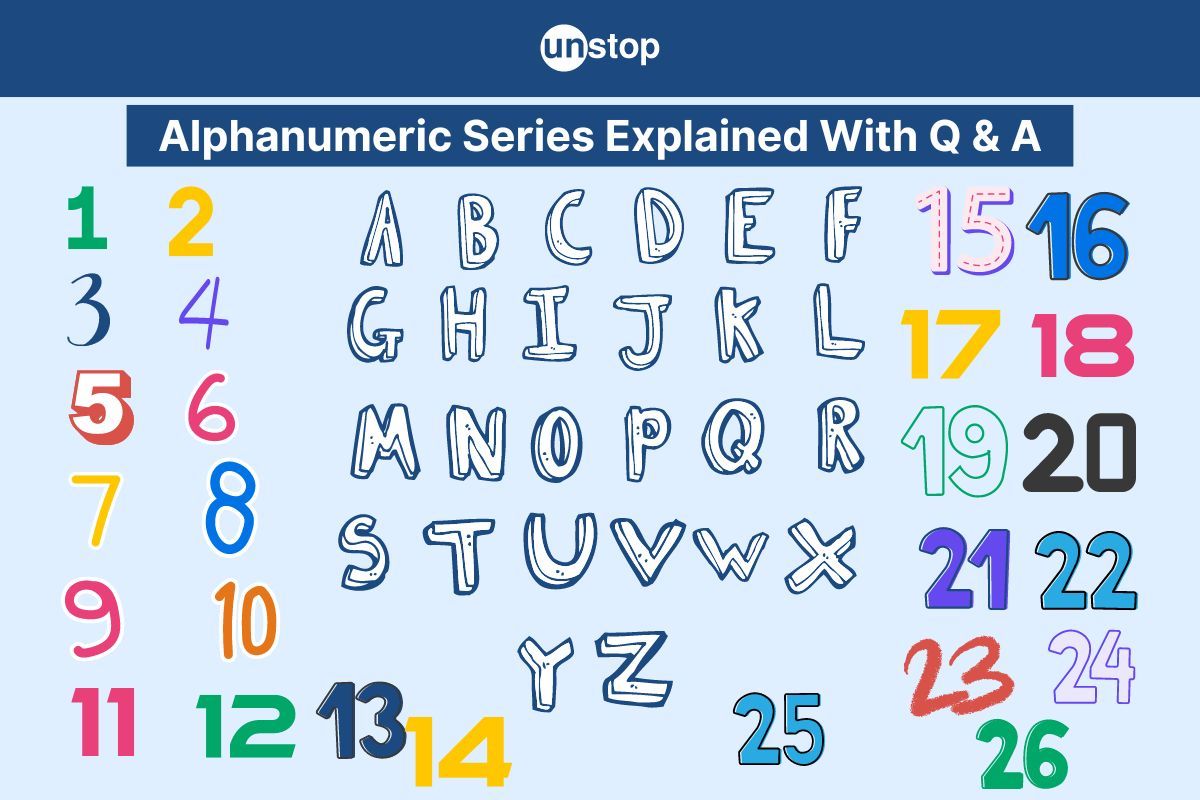- Step 1: The Groundwork
- Step 2: The Three Sections
- Step 3: Practice Makes Improvement
- The Secret Ingredient
- Understanding Basics Of Number Series
- Types Of Number Series Reasoning Questions
- Addition & Multiplication In Number Series
- Square & Cube-Based Number Series Patterns
- Missing Terms & Arranging Sequences
- Tricks & Tips For Solving Number Series
- Selected Number Series Questions With Solutions
- Frequently Asked Questions (FAQs)
- Must Know Terminologies in Blood Relation Questions
- Basic Approaches to Solve Blood Relation Questions
- Types Of Blood Relation Questions
- Tips For Solving Blood Relation Questions
- Multiple Choice Questions (MCQs) with Detailed Explanation
- Conclusion
- Frequently Asked Questions (FAQs)
- Letter Series In Logical Reasoning
- Types Of Letter Series Patterns
- Tips For Solving Letter Series Reasoning
- Best Practice Question Samples With Answers
- Conclusion
- Frequently Asked Questions (FAQs)
- Basics of Problems On Age-Related Questions
- Formula to Solve Problems on Ages-Related Questions
- Types of Age-Related Questions & Examples
- Tips & Tricks for Solving Ages Problems
- Best MCQs on Problems on ages with solved answers
- Conclusion
- Frequently Asked Questions (FAQs)
- Definition of Calendar
- Understanding Days of the Week
- What is a Leap Year?
- Concept of Odd Days in a Century
- Tips For Solving Calendar Reasoning Questions
- Best Calendar Reasoning Questions with Answers (MCQs)
- Frequently Asked Questions (FAQs)
- Basic Concepts of Clock
- Structure of a Clock
- Angle Equilavalence in Clock
- Tips For Solving Clock Questions
- Selected Clock Questions & Answers (MCQs)
- Conclusion
- Frequently Asked Questions (FAQs)
- Understanding The Concept Of Direction Sense
- Tips For Effective Problem-Solving In Direction Sense
- Practical Test Practice Questions And Answers
- Conclusion
- Frequently Asked Questions (FAQs)
- Importance Of Dice Reasoning
- Dice Numbers In Dice Reasoning
- Classification Of Dice
- Constructed Vs Deconstructed Dice
- Tricks & Tips For Solving Dice Problems
- Practice MCQs With Detailed Answers
- Conclusion
- Frequently Asked Questions (FAQs)
- Alphanumeric Series Defined
- Alphanumeric Series In Reasoning Tests
- Tips & Strategies For Solving Alphanumeric Series
- Practice Sample Questions With Detailed Answers
- Conclusion
- Frequently Asked Questions (FAQs)
- Concept Of Mirror Image Reasoning Explained
- Important Terms In Mirror Image Reasoning
- Types Of Mirror Images
- Identifying Correct Mirror Image
- Finding Clock's Mirror Image
- Tips To Solve Mirror Images
- Selected Practice Questions With Answers
- Conclusion
- Frequently Asked Questions (FAQs)
- Concept & Overview Of Input-Output
- Input-Output In Competitive Exams
- Types Of Input-Output Problems
- Strategies, Tips & Tricks For Solving Reasoning Questions
- Selected Practice Questions With Answers
- Conclusion
- Frequently Asked Questions (FAQs)
- Importance Of Finding The Odd One Out
- Tricks And Tips
- How to Find The Odd One Out?
- Solved MCQs with Detailed Explanation
- Conclusion
- Frequently Asked Questions (FAQs)
- Understanding Key Concepts
- Exploring Different Ranking Types
- Formula And Application Of Order And Ranking
- Tips For Solving Order & Ranking
- Selected Practice Questions And Answers
- Conclusion
- Frequently Asked Questions (FAQs)
- Importance Of Pipes & Cistern Aptitude
- Key Terminologies used in Pipes and Cisterns
- Pipes and Cisterns Formula with Examples
- Pipes and Cisterns Shortcut Tricks
- Tips For Solving Pipes & Cistern Problems
- Selected Questions & Answers For Practice (MCQs)
- Conclusion
- Frequently Asked Questions (FAQs)
- Key Concept in Boats and Streams
- Formulas Of Boats & Streams
- Distance & Time Formula
- Tips For Solving Boats & Streams Questions
- Selected Practice Questions With Answers (MCQs)
- Conclusion
- Frequently Asked Questions (FAQs)
- Concept of Mixture and Alligation
- Types Of Alligation Questions
- Formula for Solving Mixture & Alligation
- Tips For Solving Mixture And Alligation
- Selected Questions With Answers For Practice
- Conclusion
- Frequently Asked Questions (FAQs)
- Concepts and Definitions Related to Time and Work
- Important Time And Work Formulas
- Tricks and Tips to Solve Time & Work Questions
- Time And Work MCQs with Detailed Solution
- Conclusion
- Frequently Asked Questions (FAQs)
- What is Harmonic Progression(HP)?
- Formula to find the nth Term in Harmonic Progression
- Formula to find the Sum of the nth Term in HP
- What is Harmonic Mean?
- Harmonic Progression Solved Best MCQs
- Conclusion
- Frequently Asked Questions (FAQs)
- What is Mensuration in Maths?
- What are 2D figures in Mensuration?
- What are 3D figures in Mensuartion?
- Basic Terminologies In Mensuration
- Basic 2D Formulas in Mensuration
- Basic 3D Formulas in Mensuration
- 2D vs 3D in Mensuration
- Solved Questions With Solutions (MCQs)
- Conclusion
- Frequently Asked Questions (FAQs)
- Relationship Between Time, Speed And Distance
- Conversion Units Time, Speed And Distance
- Average & Relative Speed: Two Trains Moving in the same or opposite direction
- Solved MCQs on Time, Speed And Distance
- Conclusion
- Frequently Asked Questions (FAQs)
- What is Simplification in Maths?
- BODMAS Rule in Simplification Explained
- Simplification & Approximation Relation
- Key Terms in Simplification
- Examples Of Simplification Techniques
- Simplification Questions With Solved Answers (MCQs)
- Conclusion
- Frequently Asked Questions (FAQs)
- Height And Distance Important Terms
- Right Angled Triangle In Trigonometry
- Trigonometric Ratios
- Solved Examples For Better Understanding
- Height And Distance Applications In Trigonometry
- Height And Distance Practice Questions & Answers
- Conclusion
- Frequently Asked Questions (FAQs)
- Defining Interest Types
- Simple Interest Vs. Compound Interest
- Selected Solved Questions & Answers
- Conclusion
- Frequently Asked Questions (FAQs)
- Basic Concepts Of Profit And Loss
- Determining Selling Price
- Calculating Discounts
- Formulas For Calculating Profit And Loss
- Examples Of Profit And Loss
- Profit & Loss Questions With Detailed Solution
- Conclusion
- Frequently Asked Questions (FAQs)
- Defining Angle Of Elevation
- Key Terms Used In Angle Of Elevation
- Angle of Elevation Formula with Example
- Angle of Elevation vs. Angle of Depression
- Angle of Elevation MCQs with Answers
- Conclusion
- Frequently Asked Questions (FAQs)
- Defining HCF And LCM
- Calculation Methods Of HCF And LCM
- HCF By Prime Factorization Method
- LCM By Prime Factorization Method
- Difference Between HCF And LCM
- HCF & LCM Practice Questions With Answers
- Conclusion
- Frequently Asked Questions (FAQs)
- What is fraction and decimal?
- Understanding Decimal Fraction
- Place Value in Decimal Fraction
- Mathematical Operations with Decimal Fraction
- Practice with Solved Examples
- Summary
- Frequently Asked Questions
- All About Decimals
- All About Fractions
- How to Convert a Decimal into Fraction
- Simple vs Recurring Decimals
- Converting Recurring Decimals to Fractions
- Conversion Charts
- Practice Questions (With Solutions)
- Closing Thoughts
- Frequently Asked Questions
- What is Arithmetic Mean?
- Arithmetic Mean Formula- Ungroup Data & Group Data
- Merits of Arithmetic Mean
- Demerits of Arithmetic Mean
- Alternatives to Arithmetic Mean
- What is the Weighted Arithmetic Mean?
- Arithmetic vs. Geometric Mean
- Arithmetic Mean Application in Statistical Analysis
- Arithmetic Mean Practice Questions with Explanation
- Frequently Asked Questions
- What is Geometric Progression?
- Key Properties of Geometric Progression
- General Form Of Geometric Progression
- General Term or the Nth Term of Geometric Progression
- The sum of nth Terms of GP
- Types Of Geometric Progression
- Solved Questions and Answers of GP
- Conclusion
- Frequently Asked Questions (FAQs)
- Average in Maths
- Average Formula in Maths
- Differentiating Types of Average
- How to Calculate Average of Negative Numbers?
- Practical Applications of Averages
- Average Questions For Practice
- Frequently Asked Questions
- What is Simple Interest in Maths?
- Simple Interest Formula Explained
- Simple Interest Formula for Years, Months & Days
- Simple Interest Examples & Practice Questions
- Conclusion
- Frequently Asked Questions (FAQs)
- Defining Mathematical Ratios
- Understanding Proportions Fundamentals
- Differentiating Ratios from Proportions
- Ratio and Proportion Formulas
- Properties of Ratio and Proportion
- How to Solve Ratio and Proportion Problems
- Ratio and Proportion Problems (With Solutions)
- Summary
- Frequently Asked Questions
- What is Number in Maths?
- Types of Numbers With Example
- Real vs Complex Numbers Explored
- Basic Operations on Numbers
- Practice Questions (With Solutions)
- Frequently Asked Questions
- What is Arithmetic Progression (AP) in Maths?
- Important Terminologies in Arithmetic Progression
- Basic Terms in Arithmetic Progression
- General Form Of Arithmetic Progression Series
- Types Of Arithmetic Progression
- Solved Questions With Explanation (MCQs)
- Conclusion
- Frequently Asked Questions (FAQs)
- Understanding Basic Concept
- Importance Of Train Problems In Aptitude
- Tips To Solve Train Problems
- Selected Practice Questions & Answers
- Conclusion
- Frequently Asked Questions (FAQs)
- Definition Of Mode
- Calculating Mode For Ungrouped Data
- Calculating Mode For Grouped Data
- Bimodal, Trimodal & Multimodal Distributions
- Comparing Mean, Median & Mode
- Selected Practice Questions With Answers
- Conclusion
- Frequently Asked Questions (FAQs)
- Important Concept In Races And Games
- Calculating Time, Speed & Distance
- Importance Of Races And Games Problems
- Sample Practice Questions With Answers
- Conclusion
- Frequently Asked Questions (FAQs)
- Types Of Partnership
- Formula For Partnership Questions
- Tips To Solve Partnership Aptitude Questions
- Selected Partnership Questions (Practice MCQs)
- Conclusion
- Frequently Asked Questions (FAQs)
Alphanumeric Series- Tips, Strategies, Practice Question & Answer

Alphanumeric series have been used to test logic and problem-solving skills. By practising deciphering codes and patterns, students can enhance their cognitive abilities and prepare themselves for the challenges that lie ahead in exams and job interviews.
Alphanumeric Series Defined
An alphanumeric series involves a sequence of characters that includes both alphabets and numbers. These series are commonly used in various fields for coding, data organization, and encryption purposes.
When forming an alphanumeric series, the combination typically starts with alphabets followed by numbers or vice versa. For instance, "A1B2C3" or "1A2B3C" represent simple examples of such a series.

Alphanumeric Series In Reasoning Tests
Alphanumeric series questions are common in government exams due to their effectiveness in evaluating candidates' reasoning prowess. Aspirants preparing for civil services, banking, or other government job exams must dedicate ample time to practising these questions.
Alphanumeric series questions are integral to logical reasoning tests, assessing one's logical thinking and problem-solving abilities. Mastering these questions is crucial for excelling in competitive exams.
Tips & Strategies For Solving Alphanumeric Series
Let us study some of the tips for solving alphanumeric series:

Analyzing Patterns
When solving alphanumeric puzzles, analyze patterns within the series to identify relationships between alphabets and numbers. Look for recurring sequences or transformations.
Understand the sequence's logic by observing how alphabets or numbers change from one position to another. For instance, note if there is a consistent increment or decrement in values.
Tackling Different Types
Approach different types of alphanumeric series questions strategically. For alphabetical series, focus on letter positions in the alphabet. In numerical series, pay attention to arithmetic operations or geometric progressions.
Utilize clues provided in the series to decipher the underlying rule governing the sequence. Practice with various examples to enhance your pattern recognition skills.
Rechecking Solutions
After solving an alphanumeric puzzle, recheck solutions meticulously to avoid errors. Verify each step of your reasoning process and ensure that your final answer aligns with the established pattern.
Time Management
When tackling alphanumeric series questions, preparation is key. Allocate specific time slots for practice to enhance your logical reasoning skills. Prioritize understanding of the order of characters in the series.
Regular Practice
Consistent practice not only sharpens your problem-solving abilities but also helps you recognize patterns more swiftly. Utilize a shortcut method to efficiently solve questions within the given time frame.
Practice Sample Questions With Detailed Answers
Practice is the ultimate key to excelling in the alphanumeric series! Provided below are some selected sample questions with answers:

Question 1: What comes next in the series: A1, B2, C3, D4, …?
a) E5
b) F6
c) G7
d) H8
Answer: a) E5
Explanation: Each letter is followed by a number that is one greater than the previous number, and the letter also follows the alphabetical order.
Question 2: What comes next in the series: Z1, Y2, X3, W4, …?
a) U6
b) V5
c) W4
d) X3
Answer: b) V5
Explanation: The series is decreasing in alphabetical order, and each letter is followed by a number that is one greater than the previous number.
Question 3: What comes next in the series: A1B, C2D, E3F, G4H, …?
a) H4I
b) I5J
c) J6K
d) K7L
Answer: b) I5J
Explanation: Each group has a pattern where a letter is followed by a number that is one greater than the previous number, and then another letter that is next in alphabetical order.
Question 4: What comes next in the series: Z1A, Y2B, X3C, W4D, …?
a) U6F
b) V5E
c) W4D
d) X3C
Answer: b) V5E
Explanation: The series is decreasing in alphabetical order, and each group has a pattern where a letter is followed by a number that is one greater than the previous number, and then another letter that is next in alphabetical order.
Question 5: What comes next in the series: A1Z, B2Y, C3X, D4W, …?
a) F6U
b) E5V
c) D4W
d) C3X
Answer: b) E5V
Explanation: Each group has a pattern where a letter is followed by a number that is one greater than the previous number and then another letter that is decreasing in alphabetical order.
Question 6: What comes next in the series: Z1Y, X2W, V3U, T4S, …?
a) Q6P
b) R5Q
c) S4T
d) T3U
Answer: b) R5Q
Explanation: The series is decreasing in alphabetical order, and each group has a pattern where a letter is followed by a number that is one greater than the previous number and then another letter that is next in alphabetical order.
Question 7: What comes next in the series: A1B2, C3D4, E5F6, G7H8, …?
a) H8I9
b) J10K11
c) K11L12
d) I9J10
Answer: d) I9J10
Explanation: Each group has a pattern where a letter is followed by a number that is one greater than the previous number, and then another letter that is next in alphabetical order, followed by a number that is two greater than the previous number.
Question 8: What comes next in the series: Z1Y2, X3W4, V5U6, T7S8, …?
a) Q9P10
b) R9Q10
c) S8T9
d) T7U8
Answer: b) R9Q10
Explanation: The series is decreasing in alphabetical order, and each group has a pattern where a letter is followed by a number that is one greater than the previous number, and then another letter that is next in alphabetical order followed by a number that is two greater than the previous number.
Question 9: What comes next in the series: A1Z2, B3Y4, C5X6, D7W8, …?
a) C5X6
b) D7W8
c) E9V10
d) F11U12
Answer: c) E9V10
Explanation: Each group has a pattern where a letter is followed by a number that is one greater than the previous number, and then another letter that is decreasing in alphabetical order followed by a number that is two greater than the previous number.
Question 10: What comes next in the series: Z1A2, Y3B4, X5C6, W7D8, …?
a) X5C6
b) W7D8
c) V9E10
d) U11F12
Answer: c) V9E10
Explanation: The series is decreasing in alphabetical order, and each group has a pattern where a letter is followed by a number that is one greater than the previous number, and then another letter that is next in alphabetical order followed by a number that is two greater than the previous number.
Conclusion
You now have a solid grasp of the alphanumeric series, its significance in reasoning tests, and effective strategies to tackle related puzzles. By understanding the patterns and practising with sample questions, you are well-equipped to excel in government exams. Avoid common mistakes and utilize additional resources for further practice and improvement.
Quiz Time To Test Your Mind
Frequently Asked Questions (FAQs)
1. What is an alphanumeric series?
An alphanumeric series is a sequence of letters and numbers arranged in a specific pattern or order. It is commonly used in reasoning tests to assess logical thinking and problem-solving skills.
2. Why are alphanumeric series important in reasoning tests?
Alphanumeric series help test takers enhance their analytical and logical reasoning abilities. By solving these puzzles, individuals can improve their pattern recognition, critical thinking, and decision-making skills.
3. What are some tips for solving alphanumeric puzzles?
Some of the tips for solving alphanumeric puzzles are listed below:
-
Look for patterns in the given series
-
Analyze the position of letters and numbers
-
Use the process of elimination when stuck
-
Practice regularly to improve speed and accuracy
4. How can one succeed in solving alphanumeric puzzles?
To excel in solving alphanumeric puzzles, it is essential to practice consistently, develop a systematic approach, stay focused, and utilize strategies such as identifying relationships between elements in the series.
5. Where does one find additional resources to practice alphanumeric series questions?
For extra practice on alphanumeric series questions, consider utilizing online platforms that offer reasoning test preparation materials, including sample questions, solved examples, and mock tests tailored for various government exams.
Suggested reads:
- Data Interpretation: Definition, Steps, & Practice Questions
- What Is Number In Maths: History, Types, Operations & More
- Ratio and Proportion: Mastering Fundamentals (+ Solved Questions)
- Arithmetic Progression- Notation, Formulas, Questions And Answers
- Geometric Progression- Definition, Formula, Questions & Answers
Instinctively, I fall for nature, music, humor, reading, writing, listening, traveling, observing, learning, unlearning, friendship, exercise, etc., all these from the cradle to the grave- that's ME! It's my irrefutable belief in the uniqueness of all. I'll vehemently defend your right to be your best while I expect the same from you!
Login to continue reading
And access exclusive content, personalized recommendations, and career-boosting opportunities.
Subscribe
to our newsletter
















Comments
Add comment